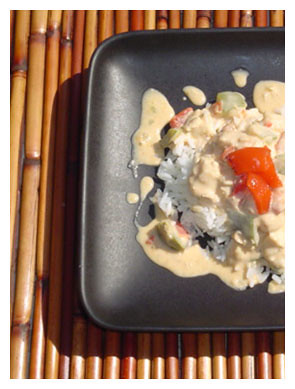 It's odd, where recipes come from. Imagine the first desperate soul who decided to dunk a lobster into boiling water--at one point the spiny things were plentiful as cockroaches and only eaten by poor fishermen who were busy fishing more profitable catch, like cod or crabs. Imagine, too, the inquisitive soul who decided the coffee bean worked best roasted, then ground, then used to filter hot water, the resulting brew much more palatable than the remaining grounds. And imagine having to eat it all. Many classic recipes (French) come from peasants forced to find ways to stretch their food as far they could. Sweetmeats, brains, livers and hearts--all of them consumed because the people had no other choice, made delicious because even the lowliest among us can be assured a certain dignity provided by delicious food and good company.
It's odd, where recipes come from. Imagine the first desperate soul who decided to dunk a lobster into boiling water--at one point the spiny things were plentiful as cockroaches and only eaten by poor fishermen who were busy fishing more profitable catch, like cod or crabs. Imagine, too, the inquisitive soul who decided the coffee bean worked best roasted, then ground, then used to filter hot water, the resulting brew much more palatable than the remaining grounds. And imagine having to eat it all. Many classic recipes (French) come from peasants forced to find ways to stretch their food as far they could. Sweetmeats, brains, livers and hearts--all of them consumed because the people had no other choice, made delicious because even the lowliest among us can be assured a certain dignity provided by delicious food and good company.
Many of us don't have to deal with that anymore. Most of us can pick from a wide variety of ingredients on a daily basis, and our menus don't even hinge on the seasons. For better or worse. Still, sometimes we stumble into a recipe by luck or chance.
Bobby Flay has a show. He has a couple, but the one I stumbled on is "Throwdown," mentioned in the New Yorker article, and a show that totally failed to grab my attention. Still, winter's coming (such that it is in Florida), and the show's subject, chowder, would be a solid shield against the season's coming cold. To make things even better, the challenger served up a chowder made with Bahamian monkfish, perfect since the Bahamas are, like, right there. Practically just up the road. Of course, hearing 'Bahamian monk fish' and obtaining Bahamian monkfish are two entirely different matters--add that to a long, random list of supporting ingredients rattled off at New York speed, and you've got a recipe for a different recipe.
I was able to remember Bahamian monk fish, bell pepper, coconut milk and curry. The curry I had in my fridge. The rest I had to grab from the local supermarket:
Ingredients
- 1 can coconut milk (13.5 fl oz.)
- 1/2 cup chicken stock
- 1 1/2 tsp. prepared Thai red curry paste
- 2 big pinches of kosher salt
- 1/2 medium shallot, diced fine
- 1/2 large green pepper, cut into bite-sized chunks
- 1/2 large red pepper, cut into bite-sized chunks
- @ 1 lb. red snapper fillets, cut into 1-inch cubes
- Begin by sweating the peppers and shallot in a large, heavy sauce pan.
- Add a couple pinches of salt.
- Once the shallots have gone a bit translucent, up the heat and add the fish. Keep the ingredients moving in the bottom of the pan until the fish goes opaque on all sides.
- Dump in the coconut milk.
- Add the curry paste and stir to combine.
- Add the chicken stock and use the remaining salt to season to taste.
- Lower the heat and let things come together for about 30 - 40 minutes.
- Serve over rice.
The resulting Asian-inspired dish is a delicate combination of spicy and sweet, the snapper and bell pepper providing a perfect counterbalance to whatever heat comes from the curry. For the real monkfish chowder, you've got to throw in monk fish, plantains and potatoes and one very fresh eel.
What to pair it with?
 Certainly not a white shiraz. If white zin is your thing (and assuming you're in America, it probably is) then maybe a white shiraz is right up your alley. And if you enjoy sweet, cloying wine with a hobo-pleasing alcohol burn, then the Little Penguin's white shiraz could be just your thing. At $6.99 a bottle, you'll have enough cash left over to spring for the bus ticket so you won't even have to ride the rails. However, if you care a whit about wine and aren't settling next to Guesstimate Jones for a freight ride to Yuma, then maybe you'll want to pair this dish with a crispy, fruity pinot grigio. My favorite happens to come out of Italian winery Ca’ Montini and is wonderfully bright with enough acid to cut through the fish's sweetness and enough fruit to enhance the sauce's peppers and curry spices.
Certainly not a white shiraz. If white zin is your thing (and assuming you're in America, it probably is) then maybe a white shiraz is right up your alley. And if you enjoy sweet, cloying wine with a hobo-pleasing alcohol burn, then the Little Penguin's white shiraz could be just your thing. At $6.99 a bottle, you'll have enough cash left over to spring for the bus ticket so you won't even have to ride the rails. However, if you care a whit about wine and aren't settling next to Guesstimate Jones for a freight ride to Yuma, then maybe you'll want to pair this dish with a crispy, fruity pinot grigio. My favorite happens to come out of Italian winery Ca’ Montini and is wonderfully bright with enough acid to cut through the fish's sweetness and enough fruit to enhance the sauce's peppers and curry spices.



No comments:
Post a Comment